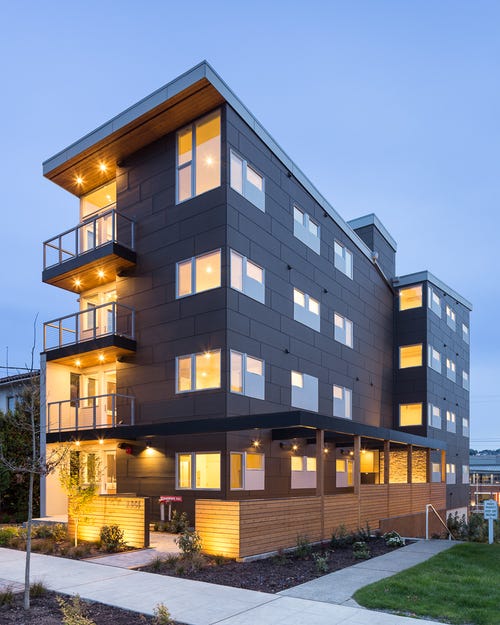Urban Proxima 2024
The year in review
Dear readers, as another year comes to a close, it might be easy to feel a bit fatigued. Speaking personally, it seems like precedent as a meaningful concept ended in 2020 and we’ve just been careening into the twelfth season of a made-for-tv dramatic series that shouldn’t have survived the last writers’ strike. It all feels very late stage Shonda Rhimes these days.
But, despite the feeling of reality collapsing into satire, there is room for hope and optimism — especially for those of us concerned with the places we live and their impact on our lives.
Have you heard the good news?
Earlier this year, the rail operator Bright Line broke ground on a high-speed rail line that will connect Las Vegas and the greater Los Angeles region. If construction finishes on schedule, it’ll be operational in time for the 2028 Olympics in LA and be the first unambiguously high-speed rail in the U.S.1
Across the way in Texas, the conversation about high-speed rail stitching together the major urban centers of the Texas Triangle has had new life breathed into it, so we may see tangible progress there as well. That’s all to say I believe the U.S. is finally going to start using what’s standard technology in Europe and Asia (and set the stage for a more prosperous future in the process).
Meanwhile, self-driving cars have continued rolling out across the U.S. with Waymo leading the pack in San Francisco, Phoenix, Austin, and Los Angeles.
Living in SF, I see them just about every day as I walk around the neighborhood and as neat as it is to ride in one, they probably impact my life more so as a pedestrian. Waymo vehicles are consistently cautious and unabashedly deferential to everything else on the road — to the point that I’m now much more nervous crossing the street in front of a (distractible) human operated vehicle than I am an autonomous one.

Good things have been happening on the policy front as well.
The city of Seattle continues to lead the country in urban infill development (especially after legalizing something called single-stair construction). The city has been adding some frankly awesome looking new housing that’s helping with affordability by adding more units of housing per (expensive) acre of urban land.2
Virginia has also started getting serious about single-stair reform this year and will hopefully follow up with more permissive rules in their next legislative session.
In New York, congestion pricing was resurrected after being put into limbo by Governor Kathy Hochul. The policy is one of those urbanist holy grails that would almost certainly do exactly what it’s intended to do (end traffic) if we could only get past the fact that everyone absolutely hates it. Well, after some political back and forth, it’s set to move forward and folks driving into Manhattan will have to start paying $9 for privilege.
In other Gotham news, the City of Yes reforms passed and will, among other things, rezone New York City to legalize the construction of an additional 80,000 units of housing. Best estimates are this is about 15% of what the city needs to get to a broad-based level of affordability, but as one NYC housing policy knower put it “the path to 100 starts with 15”.3
Circling back to Texas, we have even more tidings of cheer.
Austin rents are down 7% YoY (and that’s in the face of continued population growth). Part of the magic here is that the City of Austin (and adjacent municipalities) just allow developers to build a lot of housing. Who could have guessed that would have mattered?
Meanwhile, in San Francisco, we might be almost on the verge of starting to get our shit together. And elsewhere in California the state-level legislative progress we’ve made has started to create hilarious cracks in the anti-housing dam (see below).
Bigger picture, it’s also a great time to by a Yimby politician. A recent white paper published by Yimby Action shows that pro-housing state officials have a 95% reelection rate.4 In all fairness, we can’t claim these politicians were reelected because of their pro-housing positions; but it we can say that it’s demonstrably true that being pro-housing doesn’t invite voter backlash (at least at the state level).
Now, this isn’t an exhaustive list of everything good that happened all year long. But the point I’m hoping to drive home is that good things can — and are — happening. And, broadly speaking, we know how to keep the party going.
Austin’s pro-housing land use regime didn’t happen by accident. Yimby reformers at AURA have been doing the politics necessary to get good policy for years. Similarly, the members of Seattle Yimby are hard at work pushing the city to unblock housing production even more than it already has — and when Virginia eventually follows Settle’s lead, it’ll be because Yimbys of Northern Virginia were there to help push things along.5
Even on the technical side, self-driving cars have only become real after over a decade of advancing fundamental technologies. And when we finally get air taxis, it’ll be because of similar types of advances in aeronautics and battery tech.
So, despite how we might reasonably feel about the current state of the world, we should remember that we still have the collective capacity to do some things right and to make some things better. Tomorrow can still be better than today.
A reason to care
As I’ve continued writing this blog, I’ve had occasion to stop and ask myself “why?”.
On one level it’s as simple as me being a nerd and finding the influence of new technology on all the intricate minutiae of urban life endlessly fascinating. On a deeper level, though, it’s because I still believe people are important — and, therefore, so are cities.
Cities are the ultimate physical expression of the complexity of human society. The fact that human beings can co-habitat in the hundreds-of-thousands to tens-of-millions is a testament to what we can create as a species.
The economic opportunities we enjoy, the ways in which we get to spend our time, even the people with whom we have the chance to fall in love, are all functions of the places we live. Cities, by bringing people into community en masse, increase our surface area to serendipity in a thousand, beautiful, different ways (when we get things right, of course).
Having a cafe in your neighborhood is good; being able to walk to it on a sunny day is great; the unexpected conversation you have waiting in line because you were wearing that one obscure band t-shirt that no one should recognize because you were in Portland and At the Drive In was really more of a Southwest regional group specific to Texas in the early aughts…is priceless.
Obviously, no city is perfect and every city is different. But that’s why enabling urban growth and addressing all the challenges that come with it is so important. Some of that is technological. Some of that is legal and political. All of it is important, though, because the places we live are the pages upon which we author the story of our lives.
So, as the year meanders to a close, here’s the thought I want to leave y’all with: Cities matter because people matter and building better places for more people is a mission that goes deeper than bloodless technocratic concerns alone.6
Well folks, I think that’s all I got for the year. We’ll back online bright in early in January with some posts that I hope will be equal parts educational and thought provoking (and maybe controversial?).
In the meantime, here’s to the end of 2024 and to looking ahead with a determined species of optimism and a resolute belief that we, individually and collectively, can still get something right — and build a tomorrow that’s better than today in the process.
150 mph is the unofficial definition for high-speed in the context of rail and Amtrak’s Acela line achieves speeds of over 150 mph for some specific stretches. Also, Bright Line’s train in Florida travels at speeds of ~125 mph, so high-speed-ish.
In high cost metros, the cost of housing is driven by the price of land (as opposed to the building). In some places, land is as much as 67% of the total cost of a property, so the more we can spread that cost out across multiple units of housing, the more affordable housing can become.
This particular New York-knower is Alex Armlovich of the Niskanen Center who, policy credentials aside, gives thoroughly awesome e-bike tours of New York. If you ever get the chance to take one, they’re worth the price of admission (approximately one beer).
Full disclosure: I currently serve as Yimby Action Board Chair.
Both Seattle Yimby and Yimbys of Northern Virginia are member chapters of Yimby Action (go team).
Which is not to say I don’t LOVE a totally exsanguinated conversation about municipal finance or zoning reform.





Beautiful stuff, Jeff. Thanks for writing!